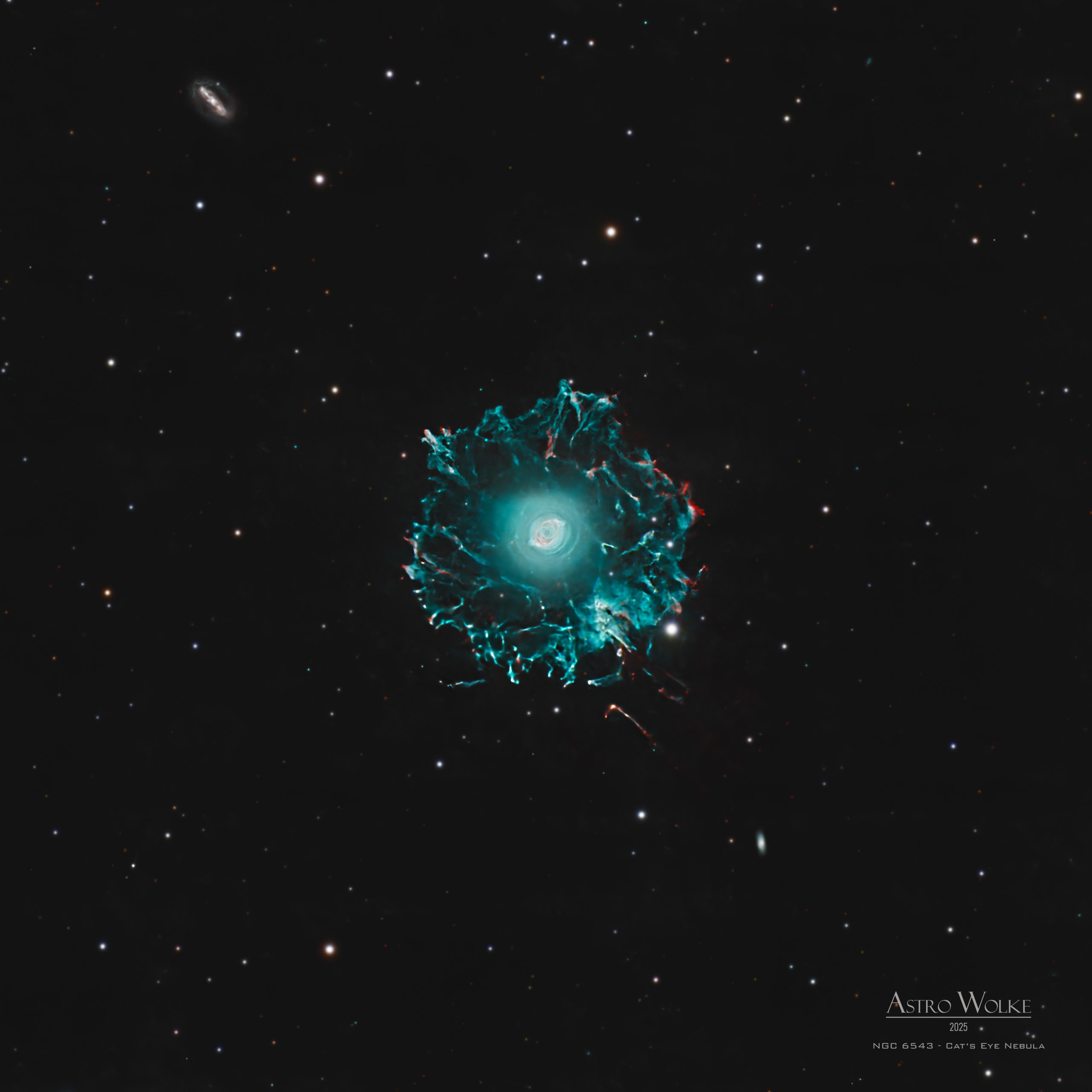The Cat’s Eye Nebula, also known as NGC 6543, is a stunning planetary nebula located in the constellation Draco, about 3,000 light-years from Earth. It is considered one of the most complex and best-studied planetary nebulae known. Its distinctive shape resembles the eye of a cat, giving it its popular name. The nebula features multiple concentric rings, symmetrical gas shells, as well as shock waves and jets, indicating repeated, energetic ejections during the late life stages of the central star. The Cat’s Eye Nebula formed from a sun-like star that shed its outer layers near the end of its life. At its core lies an extremely hot white dwarf with a surface temperature of about 80,000 Kelvin, which ionizes the expelled gas and causes it to glow. First discovered in 1786 by William Herschel, the nebula was later captured in extraordinary detail by the Hubble Space Telescope. Its complex geometry suggests the influence of a binary companion or strong magnetic fields on the star’s mass loss.
Der Katzenaugen-Nebel (Cat’s Eye Nebula), auch bekannt als NGC 6543, ist ein besonders eindrucksvoller planetarischer Nebel im Sternbild Drache (Draco). Er liegt etwa 3.000 Lichtjahre von der Erde entfernt und gehört zu den komplexesten und bestuntersuchten Nebeln dieser Art. Die auffällige Form erinnert an das Auge einer Katze – daher der Name. Die Struktur zeigt mehrere konzentrische Ringe, symmetrische Gasblasen, sowie Schockwellen und Jets – ein Zeichen für wiederholte, energiereiche Auswürfe in der Spätphase des Sternenlebens. Entstanden ist der Katzenaugen-Nebel aus einem sonnenähnlichen Stern, der seine äußeren Hüllen abgestoßen hat. Im Zentrum befindet sich ein extrem heißer Weißer Zwerg mit einer Oberflächentemperatur von etwa 80.000 Kelvin, der das ausgestoßene Gas ionisiert und zum Leuchten bringt. Die Nebelstruktur wurde bereits 1786 von William Herschel entdeckt und später vom Hubble-Weltraumteleskop in beispielloser Detailtiefe fotografiert. Ihre komplexe Geometrie lässt vermuten, dass ein Begleitstern oder Magnetfelder die Auswurfmuster beeinflusst haben.
Details
Total Integration: 28h 22‘ 30’’
R: 27x30s (13’ 30’’) – 15.05.2025
G: 30x30s (15’) – 15.05.20225
B: 30x30s (15’) – 15.05.2025
Ha: 130x180s (6h 30’) – 08.04.2025
Oiii: 423x180s (21h 9’) – 10.04./12.04./10.05./11.05./12.05.2025
FOV: 0.31° x 0.31°
Pixel scale: 0.26″/pixel
Dithering: 2 pixels every 5 images
Gain: 100
Sensor temperature: -10°C
Recording: ZWO ASI 533 MM
Filter: Baader CMOS 2’’
Optics: Celestron C8EHD + Celestron Reducer 0.7x
Guiding: ZWO ASI 220 MM / ZWO OAG-L
Mount: iOptron CEM70
Control: ZWO ASIAIR Plus Software: PixInsight + Photoshop
Darks: 30
Flats: 20
Flat-Darks: 20


Comments are closed